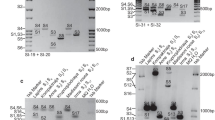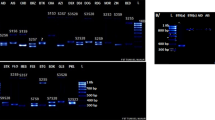Abstract
A total of 17 pollen incompatibility groups in sweet cherry (Prunusavium L.) were identified among 46 accessions by PCR based S-alleletyping analysis and by controlled test pollinations. Two putativeS-alleles different from S 1 to S 6,S z and S y were identified. Five S-genotypes, S 1 S 5, S 1 S 6,S 2 S 6, S 4 S 6, andS 5 S 6, combinations of S 1 toS 6 alleles that had not previously been identified from cultivars in NYSAES, were positively confirmed by PCR based S-genotyping analysis. Also, the S-genotypes of cultivars in some pollen incompatibility groups that had previously been incorrectly reported have been clarified. Several popular cultivars, which were previously used as testers for S-allele typing analysis, were found to have been inaccurately genotyped. In addition, the S-genotypes and self-incompatibility groups of some relatively recentlyintroduced cultivars were identified. The molecular typing system ofS-genotypes based on PCR is a useful and rapid method for identifying newS-alleles and incompatibility groups in sweet cherry.
Similar content being viewed by others
References
Anderson, M.A., E.C. Cornish, S-L. Mau, E.G. Williams, R. Hoggart, A. Atkinson, I. Bonig, B. Grego, R. Simpson, P.J. Roche, J.D. Haley, J.D. Penschow, H.D. Niall, G.W. Tregear, J.P. Coghlan, R.J. Crawford & A.E. Clarke, 1986. Cloning of cDNA for a stylar glycoprotein associated with expression of self-incompatibility in Nicotiana alata. Nature 321: 38–44.
Boskovic R., K. Russell & K.R. Tobutt, 1997. Inheritance of stylar ribonucleases in cherry progenies, and reassignment of incompatibility alleles to two incompatibility groups. Euphytica 95: 221–228.
Breiger, F.G. & A.J. Mangelsdorf, 1926. Linkage between a flower factor and self-sterility factors. Proc Natl Sci USA 12: 248–255.
Brooks, R.M. & H.P. Olmo, 1997. The Brooks and Olmo Register of Fruit and Nut Varieties. 3rd edition, ASHS Press.
Broothaerts, W., G.A. Janssens, P. Proost & W.F. Broekaert, 1995. cDNA cloning and molecular analysis of two selfincompatibility alleles from apple. Plant Mol Biol 27: 499–511.
Brown, A.G., 1955. Incompatibility. John Innes Inst. Annu. Rpt. for 1954. pp. 7–8.
Choi, C., 1999. On the Genetics of Self-Incompatibility in Sweet Cherry: Identification of S-Genotypes; Genetical and Physiological Effects on Self-Fertility and Breakdown of Self-Incompatibility. Ph. D Thesis. Cornell University.
Choi, C., K. Livermore & R.L. Andersen, 2000. Sweet cherry pollination: Recommendation based on compatibility groups and bloom time. J Amer Pomol Soc 54: 148–152.
Crane, M.B. & A.G. Brown, 1937. Incompatibility and sterility in the sweet cherry, Prunus avium L. J Pomol Hort Sci 15: 86–116.
Crane, M.B. & A.G. Brown, 1955. Incompatibility and varietal confusion in cherries. Scientia Hort 11: 53–55.
Crane, M.B. & W.J.C. Lawrence, 1929. Genetical and cytological aspects of incompatibility and sterility in cultivated fruits. J Pomol Hort Sci 7: 276–301.
Crane, M.B. & W.J.C. Lawrence, 1931. Sterility and incompatibility in diploid and polyploid fruits. J Genet 24: 47–107.
D & #x2019;Aquila, R.T., L.J. Bechtel, J.A. Viteler, J.J. Eron, P. Gorczyca & J.C. Kaplin, 1991. Maximizing sensitivity and specificity of PCR by preamplification heating. Nucleic Acids Res 19: 37–49.
de Nettancourt, D., 1977. Incompatibility in Angiosperms. Springer-Verlag, Berlin.
Doyle J.I. & J.L. Doyle, 1987. A rapid DNA isolation procedure for small quantities of fresh leaf tissue. Phytochem Bull 19: 11–15.
Frankel, R. & E. Galun, 1977. Pollination Mechanisms, Reproduction and Plant Breeding. Springer-Verlag, Berlin, New York.
Janssens, G.A., I.J. Goderis, W.F. Broekaert & W. Broothaerts, 1995. A molecular method for S-allele identification in apple based on allele-specific PCR. Theor Appl Genet 91: 691–698.
Knight, R.L., 1969. Abstract Bibliography of Fruit Breeding and Genetics to 1965, Prunus. Commonwealth Agricultural Bureaux, pp. 540–544.
Mak, Y-M. & K-K. Ho, 1993. Use of polyethylene glycol for puri-fication of DNA from leaf tissue of woody plants. BioTechniques 14: 735–736.
Maniatis, T., E.F. Fritsch & J. Sambrook, 1982. Molecular Cloning. A Laboratory Manual. Cold Spring Harbor Laboratory Press, Cold Spring Harbor, NY.
Matthews, P. & P. Dow, 1966. Studies of Sweet Cherry. John Innes Inst. Annu. Rpt. for 1966. pp. 30–31.
Matton, D.P., N. Nass, A.E. Clarke & E. Newbigin, 1994. Self-incompatibility: How plants avoid illegitimate offspring. Proc Natl Acad Sci USA 91: 1992–1997.
McClure, B.A., V. Haring, P.R. Ebert & M.A. Anderson, 1989. Style self-incompatibility gene products of Nicotiana alata are ribonucleases. Nature 342: 955–957.
McClure, B.A., J.E, Gray, M.A., Anderson & A.E., Clarke, 1990. Self-incompatibility in Nicotiana alata involves degradation of pollen rRNA. Nature 347: 757–760
Norioka, N., S. Norioka, Y. Ohnishi, T. Ishimizu, T. Oneyama, T. Nakanishi & F. Sakiyama, 1996. Molecular cloning and nucleotide sequences of cDNAs encoding S-allele specific stylar RNases in a self-incompatibility cultivar and its self-compatible mutant of Japanese pear, Pyrus pyrifolia Nakai. J Biochem 120: 335–345.
Rogers, S.O. & A.J. Bendich, 1994. Extraction of total cellular DNA from plants, algae and fungi. In: Plant Molecular Biology Manual, Kluwer Academic Publishers. D1: 1–8.
Sassa, H., H. Hirano & H. Ikehashi, 1992. Self-incompatibility-related RNases in styles of Japanese Pear (Pyrus serotina Rehd.). Plant Cell Physiol 33: 811–814.
Sassa, H., N. Mase, H. Hirano & H. Ikehashi, 1994. Identification of self-incompatiblility-realted glycoproteins in styles of apple (Malus ×domestia). Theor Appl Genet 89: 201–205.
Sassa, H., T. Nishio, Y. Kowyama, H. Hirano, Y. Koba & H. Ikehashi, 1996. Self-incompatibility (S) alleles of the Rosaceae encode members of a distinct class of the T2/S ribonuclease superfamily. Mol Gen Genet 250: 547–557.
Schmidt, H., A.B. Wolfram & R. Boskovic, 1999. Flower biology in sweet cherries. Erwerbsobstbau 41: 42–54.
Schmidt, H. & E.D. Timmann, 1997. On the genetics of incompatibility in sweet cherries 1. Identification of S alleles in self-incompatible cultivars. Gartenbauwissenschaft 62: 102–105.
Tao R., H. Yamane, H. Sassa, H. Mori, T.M. Gradziel, A.M. Dandekar & A., Sugiura, 1997. Identification of stylar RNases associated with gametophytic self-incompatibility in almond (Prunus dulcis). Plant Cell Physiol 38: 304–311.
Tao, R., H. Yamane, A. Sugiura, H. Murayama, H. Sassa & H. Mori, 1999. Molecular typing of S-alleles through identification, characterization and cDNA cloning for S-RNases in sweet cherry. J Amer Soc Hort Sci 124: 224–233.
Tehrani, G., 1984, Viscount sweet cherry. HortScience 19: 451.
Tehrani, G. & F.H. Dickson, 1974. Vogue sweet cherry. HortScience 9: 151.
Tehrani, G. & S.K. Brown, 1992. Pollen-incompatibility and self-fertility in sweet cherry. Plant Breed Rev 9: 367–388.
Tomimoto, Y., T. Nakazaki, H. Ikehashi, H. Ueno & R. Hayashi, 1996. Analysis of self-incompatibility-related ribonucleases (SRNases) in two species of pears, Pyrus communis and Pyrus ussuriensis. Scientia Hort 66: 159–167.
Tromp, J. & O. Borsboom, 1994. The effect of autumn and spring temperature on fruit set and on the effective pollination period in apple and pear. Scientia Hort 60: 23–30.
Way, R.D., 1968. Pollen incompatibility groups of sweet cherry clones. Proc Am Soc Hort Sci 92: 119–123.
Williams, W. & A.G. Brown, 1956. Genetic response to selection in cultivated plants: Gene frequencies in Prunus avium. Heredity 10: 237–245.
Williams, W. & J.S. Gale, 1960. Effect of selection on the frequency of genotypes determining incompatibility in Prunus avium. Nature, London 185: 944–945.
Author information
Authors and Affiliations
Rights and permissions
About this article
Cite this article
Choi, C., Tao, R. & Andersen, R.L. Identification of self-incompatibility alleles and pollen incompatibility groups in sweet cherry by PCR based s-allele typing and controlled pollination. Euphytica 123, 9–20 (2002). https://doi.org/10.1023/A:1014403802677
Issue Date:
DOI: https://doi.org/10.1023/A:1014403802677




